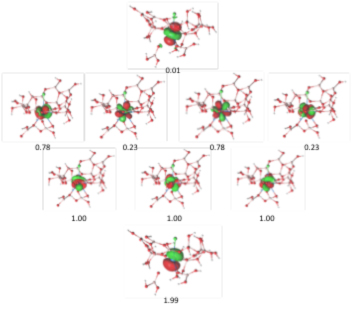

Main navigation | Main content

Working with scientists at the University of Notre Dame in Indiana and at the Christian-Albrecht University in Germany, Department of Chemistry Professor Laura Gagliardi has published a new research article, "Differentiating between Trivalent Lanthanides and Actinides," in the Journal of the American Chemical Society.
The reactions of LnCl3 with molten boric acid result in the formation of Ln[B4O6(OH)2Cl] (Ln = La − Nd), Ln4[B18O25(OH)13Cl3] (Ln = Sm, Eu), or Ln[B6O9(OH)3] (Ln = Y, Eu – Lu). The reactions of AnCl3 (An = Pu, Am, Cm) with molten boric acid under the same conditions yield Pu[B4O6(OH)2Cl] and Pu2[B13O19(OH)5Cl2(H2O)3], Am[B9O13(OH)4]•H2O, or Cm2[B14O20(OH)7(H2O)2Cl].
These compounds have been synthesized in Professor Thomas E. Albrecht-Schmitt's research group in the Department of Chemistry and Biochemistry and Department of Civil Engineering and Geological Sciences at the University of Notre Dame. They have been investigated with quantum chemical methods by Professor Gagliardi's research group at the University of Minnesota in order to rationalize the differences in their electronic structures.
These compounds possess three-dimensional network structures where rare earth borate layers are joined together by BO3 and/or BO4 groups. There is a shift from ten-coordinate Ln3+ and An3+ cations with capped triangular cupola geometries for the early members of both series to nine-coordinate hula-hoop geometries for the later elements. Cm3+ is anomalous in that it contains both nine- and ten-coordinate metal ions. Despite these materials being synthesized under identical conditions, the two series do not parallel one another. Electronic structure calculations with multireference, CASSCF, and density functional theory, DFT, methods reveal the An 5f orbitals to be localized and predominately uninvolved in bonding. For the Pu(III) borates, a Pu 6p orbital is observed with delocalized electron density on basal oxygen atoms contrasting the Am(III) and Cm(III) borates, where a basal O 2p orbital delocalizes to the An 6d orbital. The electronic structure of the Ce(III) borate is similar to the Pu(III) complexes in that the Ce 4f orbital is localized and non-interacting however, the Ce 5p orbital showing no interaction with the coordinating ligands.
In addition to Albrecht-Schmitt and Gagliardi, research authors include Daniel Grant from the University of Minnesota, Justin Cross, Matthew Polinski, Eric Villa and Shuono Wang from the University of Notre Dame, Evgeny Alekseev from the Institute of Energy and Climate Research in Germany, and Wulf Depmeier from the Christian-Albrecht University (University of Kiel) in Germany.
To read more about the research, go to the Journal of the American Chemical Society. The link to the article is http://pubs.acs.org/doi/abs/10.1021/ja303804r.